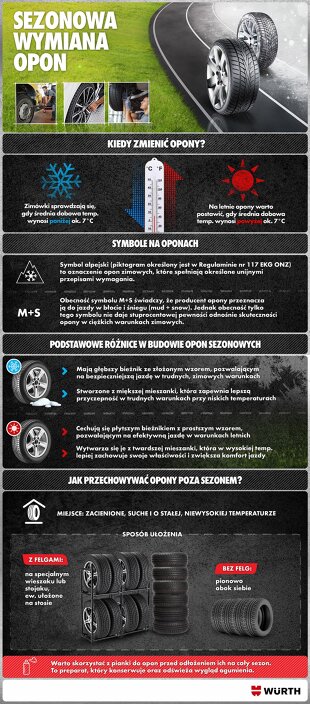
When to change tires for winter? How and where to store tires?
 Winter is fast approaching. Anticipating more frequent rains, and later ice and snow, many drivers decide to change tires in late October or early November.
Winter is fast approaching. Anticipating more frequent rains, and later ice and snow, many drivers decide to change tires in late October or early November.
 The change of seasons is an incentive for many drivers to consider whether it would be better to forgo tire changes twice a year and rely on multi-season products. An additional challenge is finding the right place to store your summer kit. Professionals who require professionalism face other challenges. This means that their workshop must be suitably equipped.
The change of seasons is an incentive for many drivers to consider whether it would be better to forgo tire changes twice a year and rely on multi-season products. An additional challenge is finding the right place to store your summer kit. Professionals who require professionalism face other challenges. This means that their workshop must be suitably equipped.
Winter or multi-season?
It's hard to point to a precise moment when winter tires start to perform better than their summer counterparts. Experts often point to an average daily temperature of 7°C. Below this limit, it is better to bet on winter tires. This is because these tires contain more natural rubber, which allows them to perform better on winter roads. There is also a noticeable difference in their appearance. Although there is no universal tread pattern and manufacturers use different patterns, winter tires usually have a deeper, more complex tread structure that is designed to effectively remove snow from the tire and retain more grip on slippery winter roads.
See also: driver's license. Can I watch the exam recording?
Despite the benefits of winter tires, many drivers don't want to change tires twice a year. They are prepared with all-season tires, also known as multi-season tires, which do not need to be replaced every winter or summer. This solution is especially suitable for people who do not drive many kilometers a year, but prefer short or infrequent routes. All-season tires are easier to use in the city than in the provinces, where the risk of getting on a completely cleared or icy road increases. Manufacturers offer better and better all-round tires every year, but it is worth remembering that in difficult winter conditions they can behave worse than their counterparts designed specifically for this season of the year.
Proper storage of tire sets after the respective seasons can be problematic. Not every car owner has a garage or enough space in their house or basement. Some choose warehouse or workshop services. Whether tires are stored by vehicle owners or professionals, the rules for proper storage remain the same. Removed summer tires should be stored in a shady, dry place with a constant and preferably low temperature. It is also important to organize them. Tires without rims should not be stacked on top of each other, as stacking can cause deformation, especially those tires that are at the very bottom. It is much better to arrange them vertically next to each other. Some people advise turning them over from time to time so that the pressure of months on one side does not make it uneven. The situation is different with tires with discs, since they must be hung on a special suspension or wheel stand. They can also be stacked, although the pros advise repositioning them every few weeks to prevent possible warping.
Proper placement in the right place is only a partial recipe for proper tire storage. Rubber, like most materials, requires maintenance. This is achieved by the use of appropriate drugs. - Both tires stored in a home basement and taken to a professional storage require proper care. In both cases, it is recommended to use a tire care foam that protects the material from UV rays, ozone or cracking caused by the passage of time. This preparation displaces dust and dirt and keeps the tires looking their best. The foam is evenly sprayed onto the cleaned surface of the tire, after which it is enough to wait for it to dry. says Jacek Wujcik, product manager at Würth Polska.
What do experts use when changing tires?
Owners who decide to purchase different sets of tires have to replace them twice a year. Professionals who do this professionally are equipped with an arsenal of tools and tools that make the job easier. Due to the high volume of customers during high season, they need to be sure that the tools and resources they use will allow them to service many vehicles efficiently.
- The key to efficient tire changes is the right bucket. The best tools of this type are made of durable chrome vanadium steel, and some of them are additionally equipped with a protective plastic coating. Other products that allow you to work without fail are the paste and the matching brush. The correct mounting paste should not come into contact with the rubber and the wheel rim. It must also keep the rubber soft and provide a tight seal. explains Jacek Wojcik from Würth Polska.
It is worth describing the dismantled tire with chalk specially designed for this purpose, which is resistant to water. Thanks to this promotion, we will avoid the wrong tire fitting next season. The way to change tires depends on their type, but in many cases it can only be on one axle.
See also: Third generation Nissan Qashqai
